I always describe my automotive taste as eclectic. I am drawn to classic muscle and pony cars, while I respect traditional luxury vehicles and European exotics. However, small cars are undeniably attractive, especially when they are original and unrestored. That is why I like this 1960 Renault 4CV. It recently emerged from a barn, a spot it occupied for an incredible sixty-three years. That means it saw little active service before hibernation, making the claimed odometer reading of 27,000 original miles conceivable. I must say a big thank you to eagle-eyed Barn Finder T.J. for spotting this fantastic French rough diamond.
Post-war Europe saw an explosion of small and affordable cars as governments sought to stimulate their economies by making the population mobile. It saw the rise of vehicles like the Volkswagen Beetle, the Citroen 2CV, and the Fiat 500. Renault joined the party in 1947 with the 4CV, which remained in production until 1961. It featured tiny exterior dimensions but could comfortably seat four people. That characteristic and the affordable price help explain why it was the first French car to sell more than one million units. Our feature car rolled off the line in 1960, and there is something “right” about the first owner’s decision to order it in Capri Blue. Certain paint shades are readily identifiable with vehicles from various nations, with Blue and France being perfect examples. The seller states it hibernated for over sixty-three years, suggesting it only saw around a year of active service before its owner parked it. This is a genuine survivor, and while there is visible surface corrosion in some areas, the seller describes the car as solid. The buyer will probably follow a nut-and-bolt process with their build, but it sounds like it won’t involve much cutting and welding. There is another option worth considering. The seller claims the paint is original, and it doesn’t look too bad below the dust layer. Therefore, careful cleaning and polishing may allow it to preserve a large slice of its survivor status. Many trim pieces will be destined for a trip to the platers, and the photos suggest the new owner faces a search for a replacement back window. Otherwise, it appears this project might be relatively straightforward.
The 4CV is tiny by modern standards, and with only 1,257 lbs to shift, it didn’t need a large engine to produce acceptable performance. Renault selected a rear-mounted 747cc four-cylinder motor generating 27hp and 41 ft/lbs of torque. Shifting duties fall to a three-speed manual transmission, while four-wheel drums provide the braking power. Outright speed wasn’t the aim of the exercise with the 4CV, which is graphically demonstrated by the 24.9-second ¼-mile ET and top speed of 62mph. However, these little classics could happily bop along at 50mph while delicately sipping their fuel. Unsurprisingly, after sixty-three years of hibernation, this Renault doesn’t run or drive. The seller claims it has a genuine 27,000 miles on its odometer, which sounds feasible if its storage history is verifiable. It sits on its original tires, and revival may not be difficult if the engine turns.
The originality of this Renault extends to its interior, which could be the most satisfying aspect of the project. The upholstered surfaces are dirty, but there is no evidence of significant wear or rips. Therefore, a deep clean may return everything to a presentable state without the cost of a retrim. It would be worth a try because it will cost nothing but time. The painted surfaces aren’t to the same standard and would require a refresh. The gauge cluster is in good order, and the wheel has survived remarkably well. The 4CV represented motoring at its most basic, so potential buyers shouldn’t search for luxuries like a radio.
I can’t conclude this article without admitting bias towards this 1960 Renault 4CV. My late father owned one of these classics, using it as his commuter option to work each day. He loved that car, eventually replacing it with a later Dauphine Gordini. However, he retained a soft spot for the 4CV for the rest of his life, stating that it is one of the few cars he owned that he regretted selling. This Renault is listed here on Craigslist in Manchester, New Hampshire. The seller set their price at $4,500, making it undeniably affordable. I hope somebody buys this classic and returns it to our roads because no classic deserves to hibernate for over six decades. If you become its new owner, I will be fascinated to receive progress reports on its restoration. I guess you could say I have a vested interest.
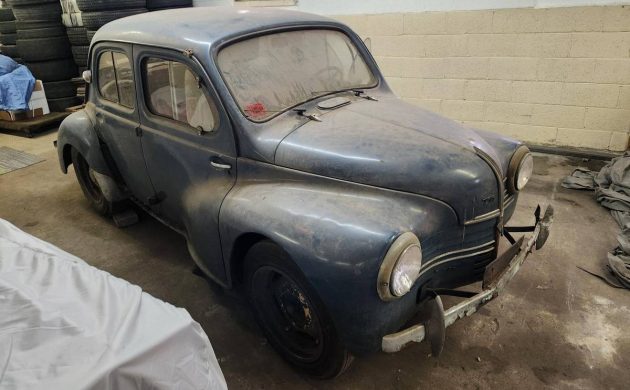
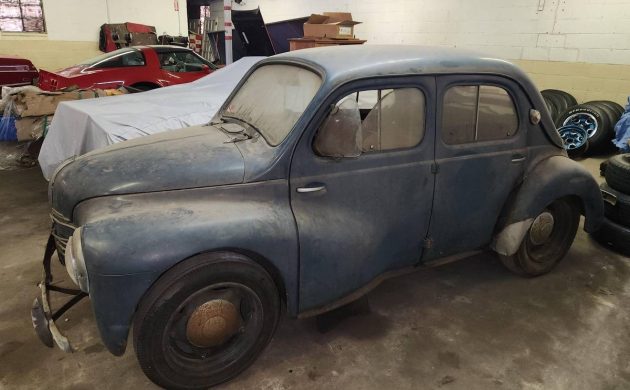
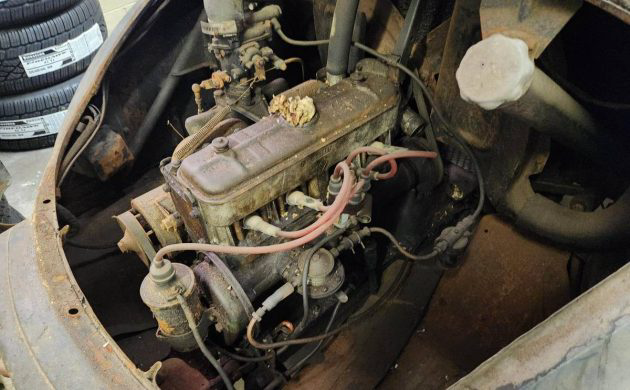
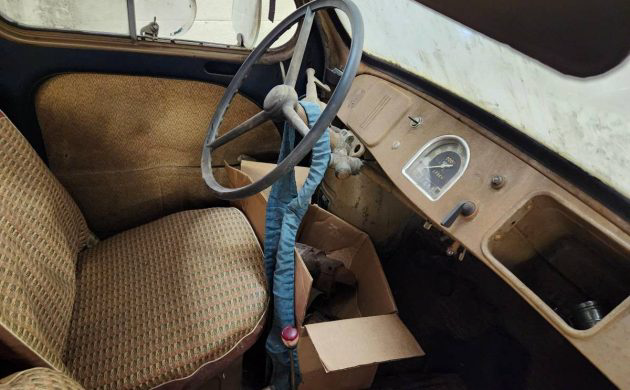
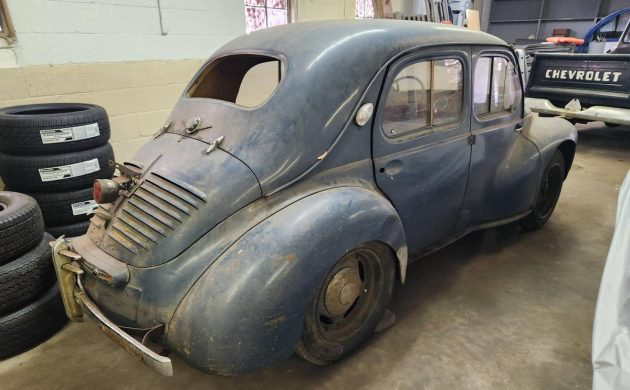


Okay then, here’s the 411 on this car, it’s not a 1960, more like a 1950, as that dash was used until 1951, also, the front and rear look to be from a different country, as 4CVs were made by Hino and Australian versions. My 1st car was a ’59 4CV, and aside from one I found near Janesville, Wis. many years ago, 50 years have gone by since I’ve seen another. Now 2 featured here is fun to see again. 4CVs were good cars, much more to offer than the Bug, 4 doors, more space, a REAL heater, and make sure you don’t put gas in the radiator. I’m sure more than once that happened, as the gas filler is under the rear hood. 4CVs were Renaults most popular car worldwide, and while horribly underpowered for the US, it could give a Bug a run for the money,,if you could wait that long.
Thank you for that HOA. I was doing some math and if the car was a 1960 and put in storage in 1961, how in the world of 50mph would there be 27K miles on it? Even if it was kilometers, that would seem like a lot in a car that you’d be hard pressed to commute 25 miles each way in. It being from the early 1950s makes more sense with closer to 10 years of use.
Oh, and BTW, a guy (I think it must be a guy) a couple of miles down the road from me has 3 or 4 of these sitting outside (along with at least 1 53 or 54 Ford). Strikes a note in the southern countryside to see a brace of them.
I’m in California, restoring a ’59 right now. I wonder if you can tell me where the “guy down the road” is located… I will need a few parts and would like to track that guy down if possible.
you can text me at 619-733-2200. Thanks
I believe HoA is correct. By the mid/late 1950s, 4CVs had a cowled instrument cluster ahead of the driver. Also, they had three-bolt disc wheels, where this car has the earlier “Star” wheels with detachable rims.
Rust was a problem. Mine, which I never drove, was badly rotted — even though a California car — and I eventually wound up acquiring a second body shell to swap the first car’s components into. Sadly, I had to move and sold it instead.
These are slightly easier to work on than Briggs & Stratton mowers. Parts aren’t the easiest to find (speaking French might help), but wrenching is simple and fun.
4CV = four hat car?
Yes, and a modern day cartoon. Would fit right into the movie ‘Cars’.
It actually stood for four cheval vapeur, which translated to four (taxable) horsepower.
IBD. Taking those two years of high school French finally paid off. ;)
OMG it’s so French!
I’ve long had an interest in basic European cars but mostly those of my 70s and 80s era. The cars we see in pre and post war designs combine European technology with American influence. To me I see a bit of 40s Plymouth with French flair. The rear engine and drive solved traction issues while minimal power should have kept you out of some trouble. Cleaned up with operational mechanicals would make this a novel mode of transport.
The 4CV was also the first attempt Renault made to shift car manufacturing to the asseblying line. The French socioligist Alain Touraine wrote an interesting essay on how this new kind of work created disaffection among the workers of the “Regie”.
I swear we musta had the very next year Dauphine (did it replace the 4cv?) as it had semaphore turn signals. That car was mom’s kid bus as she’d been down graded from the ’55 ford ranch wagon (totaled on ice – she cant B blamed as she’d just arriver in New England from a lifetime on the MD shore).
Isnt that similar @ the silver ovals on the “C” pillar?
While the Dauphine was considered the successor for the 4CV, it didn’t replace it, as they were made side by side until 1961. I don’t recall ever seeing a Dauphine with semaphore turn signals, also called “trafficators” or “Mox nix sticks”.
This is indeed an early 4CV. A 1948. Chassis number 3211 (#s 804 – 20756)
Oval tag in trunk photo (Craigslist #23) denotes R1060 chassis number 3211. There’s more, the semi-domed roof, the incredible 3 tiny red light panel above the rear number plate location. Missing bits and bobs, absolutely, but a car to restore, perhaps with subtle mods such as 4 speed and hot engine while keeping the 3 speed and original engine (engine type and number tag is below the fuel pump) with the car.
Spare tire in photo 23 blocks delivery date diamond tag in the center of the panel. Direction signal (jockey hat style) on C post is 1948 as is the open rear fender air vent. The bright trim on the rear fender under the vent is indicative of the “Luxe’ version as are the front bumper guards, the sun visors, the adjustable front window exterior vent panes, the chrome headlamp rims etc.
Definitely not a 4CV to rat rod or build a Lemons racer. A little looking here and there will unearth suitable candidates for those projects.
Definitely not 1960…..I wonder how the seller came up this year ? Front fascia wrong moustache, dashboard, steering wheel, wheels, starter location,
As JamesHGF noted, this is indeed an exceptional find. It is one of the very earliest 4CV and has things that I have never seen in real life. The tail light cluster, the 3 spoke steering wheel, the horseshoe speedometer.
Not sure when Renault started offering this color, as far as I recall all of the very earliest cars were sand beige with leftover paint from the war.
It should not be too difficult to restore, Renault had good parts interchangeability. I drove a Dauphine as my daily driver in the late 1990’s and could often use Renault 4L parts when needed.
As a side note, if someone has the means for it this super early 4CV should be very well suited for entering even the most prestigious classic car events such as Mille Miglia and the Monte Carlo rally. In fact due to the popularity of the 4CV for competition Renault later downsized the engine from 760 cc to 747 cc to get under the 750cc class.
Very much hoping that this super find can go to someone who will restore or preserve it and not get sold to someone who doesn’t appreciate its historical significance!
Just how impressive this car will be restored is shown in photos of a restored green, yes green, 1948 4CV at a Swedish Veteran car gathering in June 2016. Search for Billesholms Veteranbilstraff June 2016. It’s a “normale” rather than “Luxe” but it’s a standout.
Large red reflectors mounted on the rear bumper reinforce why someone plopped the big red taillamp on the Craigslist car.
As you stated this is an exceptional find. Even the bumpers are correct, damaged, but correct. It’s difficult for some to visualize the impact this car had, SAPAR the French accessory manufacturer produced a catalog with some 2,000 items to give your 4CV a “cachet personnel”. Amazing.
Searched leboncoin dot fr and autosout24 dot com Europe and the oldest 4CVs were early 1950s.
I’ll bet they parked it because something major broke and the owners couldn’t get the parts to service it. Either this fate or the scrapyard befell cars like this one. Lack of parts and American mechanics (especially in the South)
who refused to work on them. Would
make a really cool EV now that the bugs are being worked out today. That’s what they did with the Henney
Kilowatt. They used Dauphines to
build them at the Eureka plant in
Bloomington Illinois in 1960. My stepdad was one of the engineers that oversaw that program. Great clown car for a circus though.